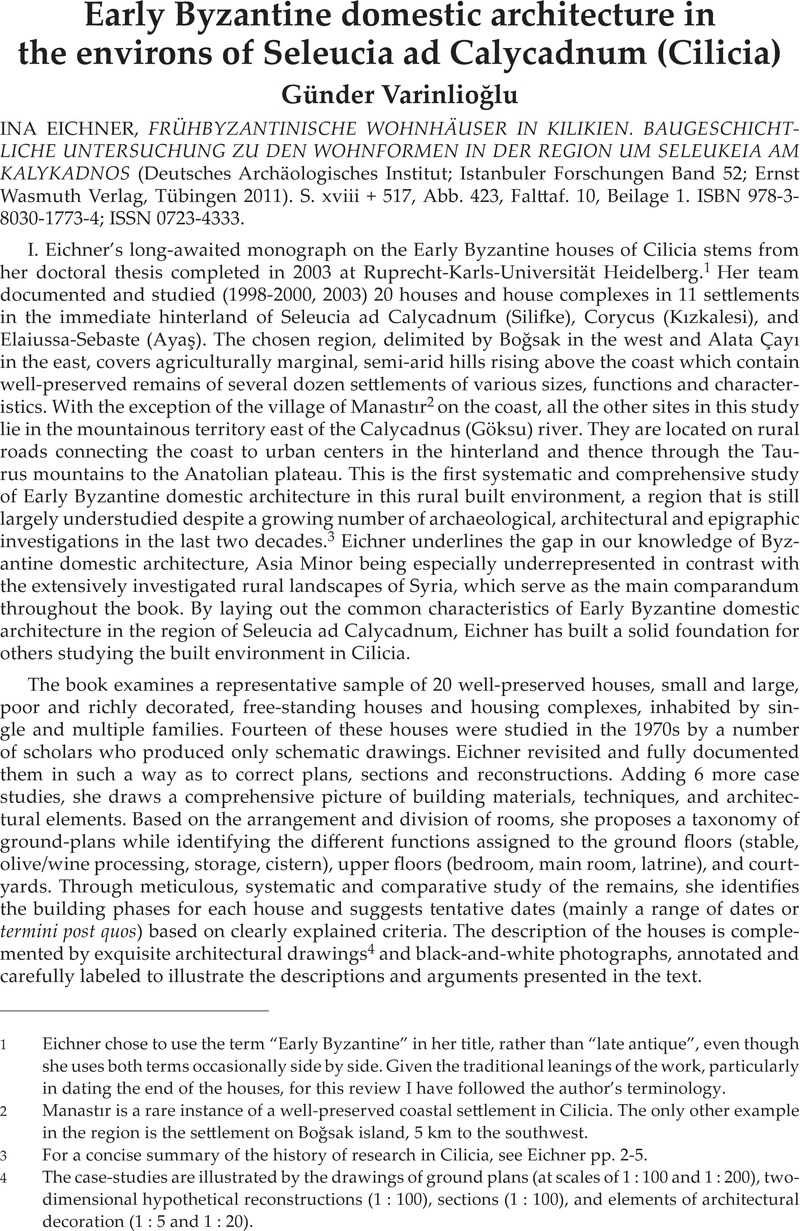No CrossRef data available.
Article contents
Early Byzantine domestic architecture in the environs of Seleucia ad Calycadnum (Cilicia) - INA EICHNER, FRÜHBYZANTINISCHE WOHNHÄUSER IN KILIKIEN. BAUGESCHICHTLICHE UNTERSUCHUNG ZU DEN WOHNFORMEN IN DER REGION UM SELEUKEIA AM KALYKADNOS (Deutsches Archäologisches Institut; Istanbuler Forschungen Band 52; Ernst Wasmuth Verlag, Tübingen 2011). S. xviii + 517, Abb. 423, Falttaf. 10, Beilage 1. ISBN 978-3-8030-1773-4; ISSN 4333-.
Published online by Cambridge University Press: 27 November 2014
Abstract

- Type
- Reviews
- Information
- Copyright
- Copyright © Journal of Roman Archaeology L.L.C. 2014
References
1 Eichner chose to use the term “Early Byzantine” in her title, rather than “late antique”, even though she uses both terms occasionally side by side. Given the traditional leanings of the work, particularly in dating the end of the houses, for this review I have followed the author’s terminology.
2 Manastır is a rare instance of a well-preserved coastal settlement in Cilicia. The only other example in the region is the settlement on Boğsak island, 5 km to the southwest.
3 For a concise summary of the history of research in Cilicia, see Eichner pp. 2-5.
4 The case-studies are illustrated by the drawings of ground plans (at scales of 1 : 100 and 1 : 200), twodimensional hypothetical reconstructions (1 : 100), sections (1 : 100), and elements of architectural decoration (1 : 5 and 1 : 20).
5 These administrative divisions refer to the re-organization of the provinces under Diocletian. By this nomenclature, the region under study lies in the provinces of Isauria and Cilicia I. Comparative examples from Cilicia II are included, but following Eichner I refer here to the region simply as Cilicia.
6 For settlement plans of Işıkkale and Karakabaklı (not made use of by Eichner), see Varinlioğlu, G., “Living in a marginal environment. Rural habitat and landscape in southeastern Isauria,” DOP 61 (2007) figs. 4 and 7Google Scholar.
7 Mango, C., “Isaurian builders,” in Wirth, P. (ed.), Polychronion. Festschrift Franz Joseph Dölger zum 75. Geburtstag (Heidelberg 1966) 358-65Google Scholar.
8 See also Eichner, I., “Spätantike und frühbyzantinische Bautechnik im südlichen Kleinasien,” in Bahmann, M. (ed.), Bautechnik im antiken und vorantiken Kleinasien (Byzas 6, 2009) 551-69Google Scholar.
9 The establishment of the Department of Archaeology at Mersin University in 1992 led to several architectural and reconnaissance surveys in this territory.
10 Two exemplary landscape surveys were carried out in the W and N parts of this territory: The Rough Cilicia Archeological Survey Project (1996-2011) in W Rough Cilicia, and the Göksu Archaeological Project (2002-6) in the upper Calycadnus valley. From 2013, a new regional survey, the Lower Göksu Archaeological Salvage Survey, is complementing the work in the Upper Göksu valley. Immediately beyond the W edge of the territory covered by Eichner the Boğsak Archaeological Survey since 2010 has been focusing mainly on the late-antique settlement on Boğsak island, but a regional survey on the coast together with its mountainous hinterland is planned.
11 Sodini, J.-P. et al., Déhès (Syrie du Nord). Campagnes I-III (1976-1978) (= Syria 57 [1980]) 1–301 Google Scholar.
12 Strzygowski, J.. Kleinasien. Ein Neuland der Kunstgeschichte (Leipzig 1903) 51 Google Scholar.
13 J. Pickett has carried out masterful energetics analyses of three masonry structures in W Cappadocia (Kızıl Kilise of the mid-6th c., Çanlı Kilise of the early 11th c., Seljuk Ağzıkarahan of the early 13th c.) and of Chingul Kurgan (Ukraine) of the 13th c.: “Energetics of construction in the thirteenth century. Three comparative case studies: Seljuk, Byzantine, and Kipchak,” Confronti su Bisanzio 2 (2014)Google Scholar.
14 Hellenkemper, H., “Eine byzantinische Baumaß,” IstMitt 39 (1989) 183 Google Scholar.
15 Turnbull, D., “Talk, templates and tradition: how the masons built Chartres Cathedral without plans,” in in Bahmann, M., Masons, tricksters and cartographers (Amsterdam 2000) 55–89 Google Scholar.




